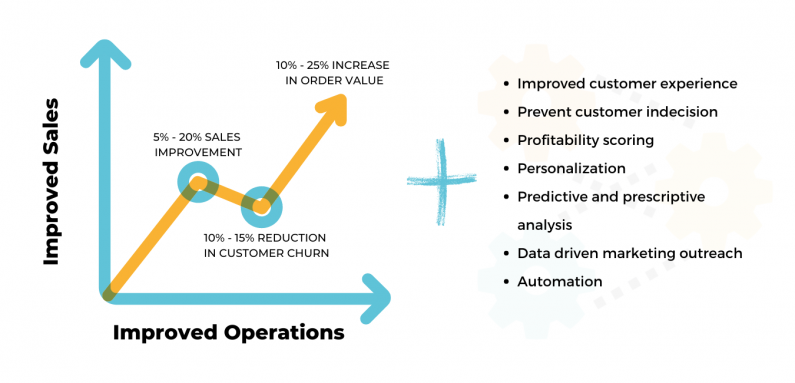Article originally appeared here.
Artificial Intelligence (AI) is getting a computer to think and act like a human. It learns from data gathered it in its own environment to help businesses make better decisions to drive top and bottom line growth.
AI has been around since the 1950s and its use has become mainstream in recent years. This is due to the success of Amazon with their product recommendations. As such, e-commerce companies became early adopters of AI-driven technologies.
AI’s benefits are being used in other areas: self-driving cars, supply chain, IT security etc. Many AI tools are API friendly and adoption is widespread. According to Grandview Research, the AI market size is projected to grow to $390 billion by 2025.
The use of AI is exploding. It is already being used in restaurant juggernauts like McDonalds and Panera. Now, how are small to mid-size restaurants supposed to compete in an industry notoriously known for slim margins?
Restaurants Aversion to Technology
Owning and operating a restaurant is not for the faint of heart. Sobering stats:
- Low profit margins averaging six percent
- High employee turnover of almost 79 percent in 2019 according to Bureau of Labor Statistics
- Rising food costs, nearing 10 percent
I’ve talked to many a restaurant owner in the past year about their technological challenges. All agreed that these would help drive growth. However, the majority put the implementation of these tools in their three-to-four year road map.
The Crippling Effects of Covid-19
Every restaurant has experienced negative side effects of this pandemic. As we begin to move forward, could the technologies discussed in the last section be the catalyst to help restaurants march towards profitability? Can AI be effectively used with these tools? Covid-19 has forced the restaurant industry’s hand to digitize their processes now instead of kicking the ‘can’ down the road if they have plans of surviving and eventually thriving.
The ‘New Normal’
Before we delve into how AI can drive growth, let’s first focus on the basics:
- Improving customer experience
- Preventing customer indecision
- Telling the customer what to do next
If you are a business leader in the restaurant vertical, can you truly accomplish these goals with your current setup in the Covid-19 world?
Most restaurants have a server based POS system that does not allow for easy access to a customer’s past orders. Often times, they require manual, onsite labor for updates that significantly increase cost of operation.
Still taking payments the old fashion way? You may want to consider changing. According to Charles Bailey, MD, medical director for infection prevention at Providence St. Joseph states that “money serves as a fomite, an inanimate vehicle by which pathogens can be spread.”
Using single-use, paper menus? While safer than traditional menus, they lack the ability to provide upsell, cross sell recommendations. Worse, paper menus don’t give you the ability to change things on the fly when food items run out.
Thinking about delivery? Restaurants are now rebelling against the exorbitant costs. Another downfall of these apps – they own all of your customer data.
How can an AI possibly help during these challenging times for restaurants?
This Isn’t Your Father’s Digital Menu
Once reserved for the Fortune 500, the democratization of AI makes it possible for businesses of all sizes to take advantage of its benefits. This includes restaurants.
In order to reopen, restaurants have to follow numerous guidelines from a food and customer safety perspective. According to the CDC, restaurants must ‘avoid sharing menus, use digital menus, and touchless payment options.’ Think of it as having a self-service kiosk right on your smartphone.
Just like Amazon with its individualized, product based recommendations, AI-driven contactless menus can provide upsell, cross sell personalized suggestions based on:
Customer’s favorite foods
- John – steak + mashed potatoes
- Mary – seared salmon + garden salad
Food drink combinations
- John – steak + mashed potatoes + California Zinfandel
- Mary – seared salmon + garden salad + Pinot Noir
Weather based food recommendations
- Winter – soup
- Summer – ice cream
According to a study by McKinsey, ‘personalization can deliver five to eight times ROI on marketing spend, and lift sales by 10 percent or more.’
Beyond the customer’s experience, it can provide the restaurant leader with the ability to:
- Take ownership of their data
- Go beyond descriptive analytics (what happened in the past) and implement predictive (what’s likely to happen) and prescriptive (next best course of action) analytics.
- Prioritize and execute, data driven omni-channel campaigns to build customer loyalty
An article by Deloitte shows that ’83 percent of AI adopters are already seeing rapid and positive changes.’
As the restaurant vertical continues to deal with the fall out of Covid-19, will we see an increased adoption of AI-driven technologies?
How Do You Eat an Elephant? One Bite at a Time
AI adoption does not have to be a scary proposition. Start off with your menu and focus on rebuilding your customer base. Next, as you grow, start incorporating data driven omni-channel outreach to drive customer loyalty. Finally, incorporate predictive and prescriptive analytics to improve operational efficiencies.
Data is a commodity. AI thrives on data. The ones who know how to harness its power will win during difficult times.
We are living in unchartered waters. Those that are clinging to ‘analog’ like technologies can hinder their Covid-19 recovery. This pandemic gives restaurant leaders opportunities to innovate and drive growth. The future is now. Get after it.

